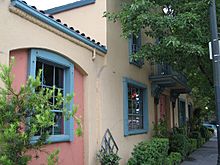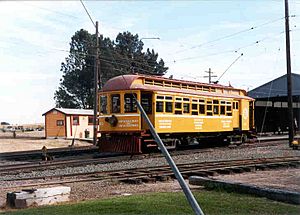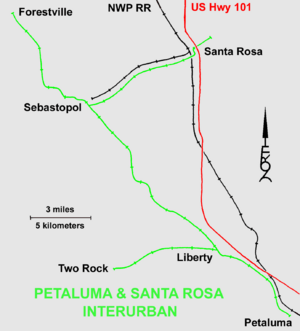Petaluma and Santa Rosa Railroad facts for kids
Quick facts for kids Petaluma and Santa Rosa Railroad |
|
|---|---|

The Petaluma & Santa Rosa Railroad Station at Railroad Square, Santa Rosa
|
|
| Overview | |
| Status | dismantled |
| Locale | Sonoma County, California |
| Service | |
| Type | interurban |
| Technical | |
| Track gauge | 4 ft 8 1⁄2 in (1,435 mm) standard gauge |
| Electrification | 600 V DC overhead lines |
The Petaluma and Santa Rosa Railroad was an electric train system in Sonoma County, California. It was called an "interurban railway" because it connected different cities. These cities included Petaluma, Sebastopol, Forestville, and Santa Rosa. The trains ran on 600 volts of electricity from wires above the tracks. The company also owned steamboats. These boats carried passengers and goods between Petaluma and San Francisco.
Today, parts of the old train tracks are now walking and biking trails. These include the West County Trail and the Joe Rodota Trail. They are managed by the Sonoma County Regional Parks Department. You can still see some of the original tracks along the waterfront in Petaluma. Some volunteers are even trying to bring back a trolley line there.
Contents
History of the Railroad
In 1903, several smaller horse-drawn streetcar companies joined together. They formed the Petaluma and Santa Rosa Railway. Their goal was to replace the slow horse cars with faster electric trains. They also planned to work with the Steamer Gold. This steamboat had been carrying people and goods since 1883.
Construction of the electric train line began in 1904. The first spike was driven into the ground in April. By October, the electric line reached Sebastopol. It then continued towards the western edge of Santa Rosa.
The Battle of Sebastopol Road
The new electric train line needed to cross the tracks of an older steam railroad. This steam railroad already had a line from Santa Rosa to Sebastopol. They did not want a new competitor. So, they refused to let the electric railway cross their tracks. In November 1904, the steam railroad even placed guards at the crossing spot. They wanted to stop the electric railway from laying its tracks.
Electric trolley service began on the west side of the steam railroad tracks in December 1904. The electric railway laid tracks and strung wires on the east side. They were ready to install the crossing. Many businesses in Santa Rosa supported the new electric line. They threatened to stop using the steam railroad. But this did not change anything.
On January 3, 1905, the electric railway crew tried to install the crossing. But the steam railroad had two locomotives waiting. These trains were ready to spray hot water on anyone who came near. The electric railway crew had to leave.
The next day, the electric railway tried a clever trick. Their trolley car #57 arrived secretly carrying the construction crew. Before the steam railway could react, the crew quickly laid temporary tracks over the steam rails. They used horses to pull trolley #57 across to downtown Santa Rosa. The steam railroad then got a court order to stop the crossing. For a few weeks, passengers had to get off one trolley, walk over the steam tracks, and then get on another trolley.
The court order was lifted in late February. On March 1, 1905, the electric railway crew returned to install the crossing. The steam railroad still tried to stop them with hot water. They even brought 150 hired tough guys from San Francisco. They also had a flat car full of gravel. Their plan was to fill in any holes the electric crew dug. Hundreds of Santa Rosa citizens gathered to watch the fight. The local police eventually brought order. The crossing was finally installed that evening.
Growing and Shrinking

With the main line working, the railroad expanded. A new line from Sebastopol to Forestville opened in July 1905. The big 1906 San Francisco earthquake stopped plans for even more lines. These plans included connections to Tomales, Dillon Beach, and other towns.
The company bought another steamboat, the Resolute, in 1912. It was renamed Petaluma. This allowed two daily boat trips to San Francisco. The original Steamer Gold burned in 1920. It was replaced by another steamboat, also named Gold.
The railroad started to decline. Passenger service on the Two Rock branch line stopped in 1925. Not enough people were riding it. In 1932, the Northwestern Pacific Railroad (NWP) bought the Petaluma & Santa Rosa. All electric trolley passenger service ended on July 1, 1932.
Ferry passenger service ended in 1935. However, the ferries continued to carry freight. The Gold steamboat was taken apart in 1940. The Petaluma made its last trip in 1950. The electric trains were replaced by diesel locomotives in 1947. The last electric motor was burned for scrap.
Over the years, more and more sections of the track were removed. By the 1980s, the line from Santa Rosa to Sebastopol was abandoned. Sonoma County bought parts of the old tracks to turn them into trails. The Northwestern Pacific Railroad continued to use the very southern part of the line in Petaluma for local businesses.
Train Route

Here are some of the main stops along the Petaluma & Santa Rosa Railroad, from south to north:
- Milepost 0 - Petaluma
- Milepost 5.1 - Liberty - This was where a branch line went west to Two Rock.
- Milepost 16.7 - Sebastopol - From here, a branch line went east to Santa Rosa.
- Milepost 23.8 - Forestville
Images for kids
-
The Petaluma & Santa Rosa Railroad Station at Railroad Square, Santa Rosa
-
A restored P&SR Car at the Western Railway Museum
-
Petaluma & Santa Rosa route with Northwestern Pacific Railroad and U.S. Route 101 shown for reference.




